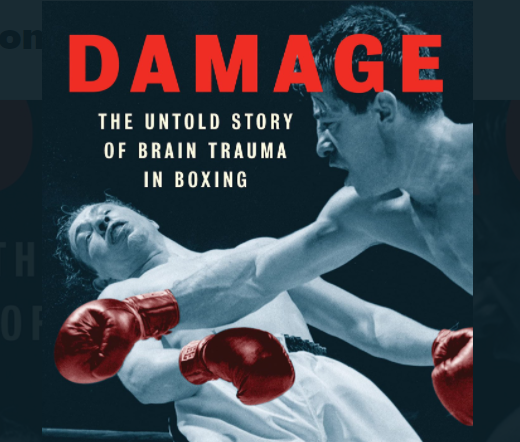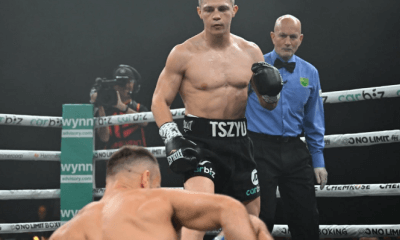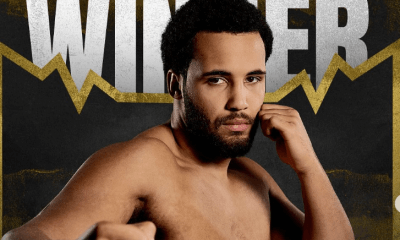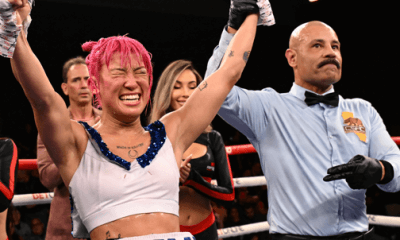Book Review
British Boxing Writer Tris Dixon Has Authored a Long-Overdue Book

British Boxing Writer Tris Dixon Has Authored a Long-Overdue Book
“Terrific beatings taken on the head reduced some of the old boxers to a state of utter simplicity in so far as their mental processes are concerned.” – Nat Fleischer “As We See It,” The Ring, October, 1924.
Nearly 100 years have elapsed since Nat Fleischer wrote those words in the influential monthly magazine that he co-founded two years earlier, the self-styled Bible of Boxing. Four more years would elapse before the term “punch drunk” entered the lexicon of medical terms. And in the ensuing years, there would be scattered reports in medical journals and to a lesser extent in boxing magazines suggesting that the condition that Fleischer described was far from rare; indeed, that some degree of neurological impairment is almost inevitable for boxers who answer the bell for many rounds (unless, of course, they happen to die young, predeceasing the decomposition).
It’s boxing’s dirty little secret and, up until now, no one has bothered to gather up the scattered medical reports and then place them along a continuum to show how our understanding of this affliction has evolved. Enter prominent British boxing writer and former amateur boxer Tris Dixon who performed this exercise for his newest book, “Damage: The Untold Story of Brain Trauma in Boxing,” the newest release from Hamilcar.
Don’t be misled. This is no dry medical treatise overburdened with polysyllabic medical jargon. True, Dixon interviewed many neuroscientists in the course of his research, but he leavened these interviews with historical tidbits and with insights culled from conversations with boxing people, fleshing out the story in imagery that will leave a lasting impression on general readers. Several of Dixon’s fellow boxing journalists turn up in the pages of this book, as do a number of retired boxers speaking candidly about a subject too often swept under the rug – Herol “Bomber” Graham, Bobby Quarry, Chuck Wepner, Matthew Macklin, Gerry Cooney, and Freddie Roach, to name just a few.
Dixon even had the foresight to interview the wives of several ring-damaged boxers: Frankie Pryor, widow of Aaron; Rose Norton, widow of Ken; and the newly-widowed Brenda Spinks, wife of Leon. These ladies, who formed a support group, provide insights from the caregivers’ perspective.
Nat Fleischer framed his quick 1924 observation in words that were insensitive and yielded a portrait of a damaged fighter that was too broad in its outline. A more exacting portrait emerged in “Punch Drunk,” a seminal 1928 paper by the noted American pathologist Dr. Harrison Martland.
Martland’s paper, notes author Dixon, established the term “punch drunk syndrome” in the medical literature, a syndrome characterized by slurred speech and Parkinson’s-like symptoms such as clumsiness in walking, memory loss, and tremors.
“Punch-drunk” was a poor choice of words; unintentionally derisive. Over time, it evolved into the somewhat less condescending pugilistic dementia and then to CTE, the acronym for chronic traumatic encephalopathy.
The early literature on punch-drunkenness assumed that second-rate boxers were most at risk, especially crowd-pleasers. That opinion would be debunked. CTE doesn’t discriminate: “Slick movers, punchers, warriors” are all susceptible.
As for ways to make the sport safer, Dixon lets his interview subjects speak for him. Neurologist Dr. Charles Bernick, who works with retired athletes at the Lou Ruvo Center for Brain Health in Las Vegas, and Tom Moyer Jr, producer of the heartbreaking documentary, “After the Last Round,” build a compelling case that boys and girls should not be pushed into boxing while their brains are still developing. In a related vein, says Dixon, there’s been talk of decorated amateurs already showing signs of slipping even before they turn pro because “all those rounds add up.”
(As an aside, this reporter was reminded of something he read while researching the career of Tacoma’s Davey Lee Armstrong, the two-time U.S. Olympian who died earlier this year from complications of dementia at age 64. In a story that appeared in the Detroit Free Press, Armstrong’s professional trainer/manager Emanuel Steward said that Armstrong, although only 26 years old and a pro for less than three full years, was already a shot fighter. “He’s been fighting since he was 9 years old. Because he was the best, he was consistently fighting the best. When you do that, the wear and tear on your body is going to be heavy…It’s just not there for him anymore. I’ve got to tell him. I can’t let anything happen to that boy. I just couldn’t deal with it if something bad happened to him,” Steward told sports columnist George Puscas. Armstrong would have three more fights before heeding Steward’s advice, leaving the professional ranks with a record of 24-3.)
Another recurrent suggestion is that boxers should do less sparring between fights. Headgear is useful for reducing the incidence of cuts, but does not diminish the long-term effects of blows to the head. Chris Nowinski, the founder of Boston’s Concussion Legacy Foundation, told Dixon that he believes that 90 percent of the damage that a boxer accrues over the course of his career comes from sparring.
Every young boxer believes that he is bulletproof, complicating reform efforts. And, it is true that CTE isn’t inevitable. Archie Moore, who had 220 documented pro fights and fought some of boxing’s hardest hitters, lived to be 81 and was sharp as a tack deep into his eighth decade. Most of the top campaigners during the Golden Era of Heavyweights struggled with neurological issues in retirement, but not George Foreman (now 72) or Earnie Shavers (77) – or at least not yet; CTE can regress from almost imperceptible to full-blown very quickly.
Then there is the hodgepodge of state regulatory bodies and the lack of uniformity between them. Moreover, it should be noted that health privacy laws prohibit individuals such as Dr. Bernick from sharing their findings with others without the consent of the boxer.
I wouldn’t lump Tris Dixon with the muckrakers of the Progressive Era. That would only be true if his intent in writing the book was to provide ammunition for the abolitionists, and it most certainly was not. As Thomas Gerbasi was quick to note in his review of “Damage,” Dixon actually loves boxing. “What (Dixon) created,” says Matt Christie, Dixon’s successor as editor of Boxing News, “is not a book that should see the sport outlawed but a survival guide for all within it.”
It would have been nice to learn more about how the great trainer Freddie Roach copes with his ring damage; the cocktail of pills he must take each day to keep his condition from worsening to where he can no longer be an effective coach. The inspirational Roach has lived with Parkinson’s-like symptoms for more than half of his adult life and yet he hasn’t let it hold him back. Also, since this is a book that I will be using as a reference source again and again, it’s frustrating that there is no index.
But what is a book review without quibbles? Kudos to Tris Dixon for writing a book that should be on the shelf of every library in every corner of the English-speaking world.
(Editor’s note: Dixon’s book provided the inspiration for Ted Sares’ latest TSS survey, arriving shortly. Also forthcoming is an interview of the author by TSS correspondent Rick Assad.)
Check out more boxing news on video at the Boxing Channel
To comment on this story in the Fight Forum CLICK HERE
-

 Featured Articles4 weeks ago
Featured Articles4 weeks agoThe Hauser Report: Zayas-Garcia, Pacquiao, Usyk, and the NYSAC
-

 Featured Articles3 weeks ago
Featured Articles3 weeks agoOscar Duarte and Regis Prograis Prevail on an Action-Packed Fight Card in Chicago
-

 Featured Articles2 weeks ago
Featured Articles2 weeks agoThe Hauser Report: Cinematic and Literary Notes
-

 Book Review2 weeks ago
Book Review2 weeks agoMark Kriegel’s New Book About Mike Tyson is a Must-Read
-

 Featured Articles4 weeks ago
Featured Articles4 weeks agoRemembering Dwight Muhammad Qawi (1953-2025) and his Triumphant Return to Prison
-

 Featured Articles6 days ago
Featured Articles6 days agoMoses Itauma Continues his Rapid Rise; Steamrolls Dillian Whyte in Riyadh
-

 Featured Articles3 weeks ago
Featured Articles3 weeks agoRahaman Ali (1943-2025)
-

 Featured Articles3 weeks ago
Featured Articles3 weeks agoTop Rank Boxing is in Limbo, but that Hasn’t Benched Robert Garcia’s Up-and-Comers


















